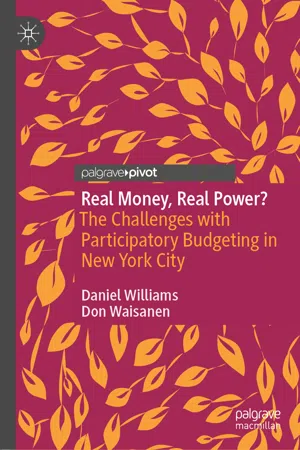Real Money, Real Power?
On a chilly September day, Dan went to a community center in Harlem to meet his graduate assistant (GA) for their first observation of a Participatory Budgeting Neighborhood Assembly. As he exited the subway and walked down a crowded New York City sidewalk a few minutes before the scheduled meeting, he received a text message from the GA advising that he might have difficulty finding the meeting. The advertised avenue address was not the entrance, so Dan would need to go to the side street and enter from the third door on the right. While passing the avenue side of the community center, he noticed a large participatory budgeting (PB) poster in the window, but no posted directions on how to get in.
Dan looked at his watch. He had blocked off plenty of time to attend the meeting yet was flustered at the possibility that he might be late. Following the GA’s directions, he found a room with three staff but, strangely, no members of the public. The two researchers briefly chatted with the staffers, who, it then became clear, were a council staff member, an intern, and the community center director, who was serving the public by providing this space but was not there to take part in the meeting.
After a while four people arrived, two together. The council staffer began the meeting by attempting to play a video supplied for the introduction to participatory budgeting. The equipment didn’t work, however. So the staffer provided his own, alternative introduction, including background on PB and a brief explanation of the type of local community project that might be eligible for citizens to vote on. He then asked for proposed projects. Only one was proposed. Two of the attendees indicated an interest in being delegates at the next, second-level meetings where the ballot is produced. It had been 32 minutes since the first constituent had arrived, the meeting was over.
This is democracy according to PB. Far from the well-orchestrated, well-attended, expansive effort at creating an inclusive and transparent form of budgeting espoused in so much of its messaging, for local citizens navigating PB can be a confusing hodgepodge of information and events, generating limited ideas, rushed meetings, and ultimately gamed by the usual suspects. Far from the ideals of a deliberative democracy, a lack of uniformity in scheduling, meeting designs, and other processes, in particular, seriously undermines the potential for citizens to have a voice in budget allocations.
The website for New York City’s participatory budgeting project (PBNYC) has, for many years, featured a video that begins with the headline: “Real Money, Real Power.” D. W. Williams, Calabrese, Gupta, and Harju (2017) show that the label “Real Money” is highly suspect from the outset, as the amount of the New York City capital budget committed to participatory budgeting is approximately 0.1% of the annual capital commitment. Participatory budgeting promotional materials assert that “Real Power” is exerted by “Real People.” We understand real power to refer to the origin story of participatory budgeting (PB) in Porto Alegre, Brazil, where, prior to reforms in the 1980s, the budget was substantially influenced, if not dominated, by clientelism. By clientelism, we mean the corrupt, corrupt-like,1 or merely unmeritorious use of governmental funds to satisfy important constituents, rather than to use the resources for general public benefit.
As Plunkitt and Riordon (1905) discuss, clientelism can be attained through raiding the public trough while using a small portion of the windfall to provide a small measure of services to constituents to generate recurrent electoral success. However, in modern times, such overt graft is generally illegal and typically avoided. Earmarks,2 also labeled “pork” (Maxey, 1919, p. 691), provide a work-around. Pork refers to the use of unmeritorious earmarks that are beneficial to individual legislators for political reasons, but are not beneficial to the general public (hence, “unmeritorious”). The link between earmarks and clientelism and their implicitly negative relation with real power creates a special concern for participatory budgeting in some of its forms. In particular, participatory budgeting in both Chicago and New York City has been implemented by the local legislative body through the use of earmarks controlled by individual council members.3 Pin (2017) has shown that when a Chicago council member became displeased with some aspect of PB, decision power was withdrawn from PB participants.
As Calabrese, D. W. Williams, and Gupta (2020) show, it is likely that New York City Council members follow the advice of PB participants by distributing their discretionary funding (earmarks) to a larger number of smaller projects than other, non-engaged council members.4 While this can reflect dispersion of power, it may alternatively enact well-honed clientelism.
In this light, this book examines previously unexplored elements of the PBNYC project. While there has been substantial study of PBNYC (Castillo, 2015; Gilman, 2012, 2016; Hagelskamp, Rinehart, Silliman, & Schleifer, 2016; Kasdan & Cattell, 2012a, 2012b; Kasdan, Cattell, & Convey, 2013; Kasdan & Markman, 2017; Kasdan, Markman, & Convey, 2014; Mayorga, 2014; Pape & Lerner, 2016; Shybalkina & Bifulco, 2019; Su, 2012, 2017a, 2017b, 2018; Urban Justice Center, 2015), there has been a limited examination of what it’s like for citizens to navigate the PB process, at the level of everyday life. As scholars concerned with maximizing citizens’ capacities to engage in democratic processes (see also Waisanen, 2012, 2014, 2018, 2020), we set our sights on what it’s like to interact with PB across a full annual cycle.
In the 2018–2019 budget preparation cycle for fiscal year 202...
